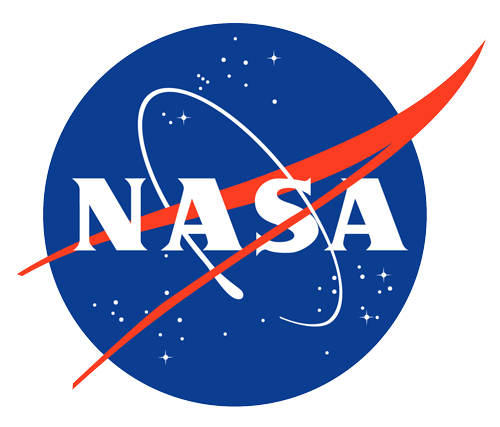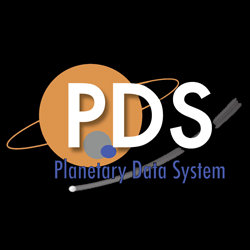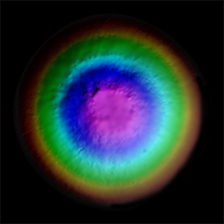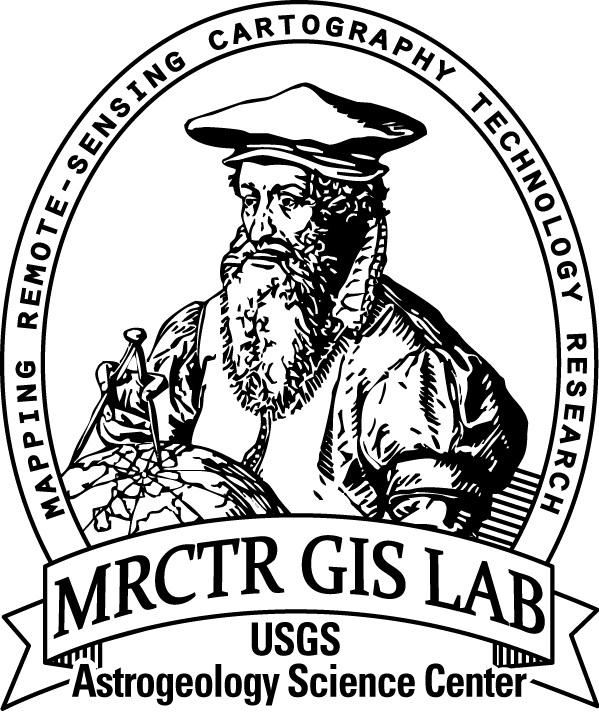Enceladus Cassini ISS Global Point Cloud
- Primary Authors
- Michael T. Bland
- Originators
- Lynn A. Weller, David P. Mayer, Brent A. Archinal
- Publisher
- USGS Astrogeology Science Center
- Publication Date
- 2020-08-28
- Abstract
- This 3D point cloud describes the global shape of Saturnâs moon Enceladus. The model is both near-global in extent and relatively high "resolution", and is intended to support scientific investigations, future mission planning activities, and generation of improved orthoimages. The global shape model was created following the conceptual approach applied to Mercury MESSENGER data by Becker et al. (2016). We first established a dense network of image tie points and photogrammetrically solved for point latitude, longitude, and radius using a least squares bundle adjustment. This point cloud includes 892,457 points. We include fields for: point longitude, point latitude, point radius, the standard deviation (in meters) of the latitude, longitude and radius, the number of measures that contributed to the point, root mean squared (RMS) pixel scale (in meters), parallax-to-height ratio, and the minimum expected vertical precision (in meters). The first six fields are calculated in the bundle adjustment. The standard deviations of the point coordinates represent one way to quantify the residual errors between the measured points and the model solution at a given point. Expected vertical precision (EP) is a function of the RMS resolution and parallax-to-height ratio of a pair of images at a measured point. The EP reported here is the smallest ratio of the RMS pixel scale to the parallax to height ratio for any image pair included in the point. Note that EP is usually scaled by the stereo matching accuracy, which is typically 0.2-0.3 pixels. Because we have not performed an independent assessment of the stereo matching accuracy, we conservatively take the accuracy to be 1 pixel. This results in conservative, but large (poor), EP values. The total expected topographic relief on Enceladus is ~2 kilometers, so we interpret points with minimum EP greater than 2 kilometers as outliers. References Archinal, B. A., Acton, C. H., A'Hearn, M. F., Conrad, A., Consolmagno, G. J., Duxbury, T., Hilton, J. L., et al. (2015). Report of the IAU Working Group on Cartographic Coordinates and Rotational Elements: 2015. Celestial Mechanics and Dynamical Astronomy 130(22). https://doi.org/10.10007/s10569-017-9805-5 Becker, K. J., Robinsons, M. S., Becker, T. L., Weller, L. A., Edmundson, K. L., Neumann, G. A., Perry, M. E., & Solomon, S. C. (2016). First global digital elevation model of Mercury. Paper presented at the 47th Lunar and Planetary Science Conference, Lunar and Planetary Institute, Houston, TX. https://www.hou.usra.edu/meetings/lpsc2016/pdf/2959.pdf Beyer, R. A., Alexandrov, O, & McMichael, S. (2018). The Ames Stereo Pipeline: NASAâs open source software for deriving and processing terrain data. Earth and Space Science, 5(9). https://doi.org/10.1029/2018EA000409 Bland, M. T., Becker, T. L., Edmundson, K. L., Roatsch, Th., Archinal, B. A., Takir, D., Patterson, G. W., et al. (2018). A new Enceladus global control network, image mosaic, and updated pointing kernels from Cassini's 13-year mission. Earth and Space Science, 5. https://agupubs.onlinelibrary.wiley.com/doi/full/10.1029/2018EA000399 Bland, M. T., Weller, L. A., Mayer, D. P., & Archinal, B. A. (2020). A global shape model for Saturn's moon Enceladus from a dense photogrammetric control network. Annals of the International Society for Photogrammetry and Remote Sensing and Spatial Information Sciences, 3, 579-586. https://doi.org/10.5194/isprs-annals-V-3-2020-579-2020 Porco, C. C., West, R. A., Squyres, S., McEwen, A., Thomas, P., Murray, C. D., Delgenio, A., et al. (2004). Cassini Imaging Science: Instrument characteristics and anticipated scientific investigations at Saturn. Space Science Review, 115, 363-497. https://doi.org/10.1007/s11214-004-1456-7 Schenk, P. M. & McKinnon, W. B. (2009). One-hundred-km-scale basins on Enceladus: Evidence for an active shell. Geophysical Research Letters, 36(L16202). https://doi.org/10.1029/2009GL039916 Tajeddine, R., Soderlund, K. M., Thomas, P. C., Helfenstein, P., Hedman, M. M., Burns, J. A., & Schenk, P. M. (2017). True polar wander of Enceladus from topographic data. Icarus, 295, 46-60. https://doi.org/10.1016/j.icarus.2017.04.019
- Purpose
- Previous shape models of Enceladus have been generated from either stereo imaging (high resolution but limited spatial extent, e.g., Schenk and McKinnon [2009]) or limb topography (global extent but lower resolution, e.g., Tajeddine et al. [2017]). This work provides a new shape model that is both near-global in extent and relatively high "resolution." The model is intended to support scientific investigations, future mission planning activities, and generation of improved orthoimages.
Contact and Distribution
- Format
- Remote-sensing Data, Tabular Data
- Access Constraints
- Public Domain
- Access Scope
- PDS
- Use Constraints
- Please Cite Authors
- Supplemental Information
- https://pds-imaging.jpl.nasa.gov/portal/cassini_mission.html, https://astrogeology.usgs.gov/search/map/Enceladus/Cassini/Enceladus_Cassini_ISS_Global_Mosaic_100m_HPF
- Native Data Set Environment
- GDAL
- Astrogeology Theme
- Photogrammetry, Topography
- Mission Names
- Cassini-Huygens
- Instrument Names
- ISS
- Online Package Link
- https://astrogeology.usgs.gov/search/map/enceladus_cassini_iss_global_point_cloud
- External File Size
- 165 MB
- Online File Link
- https://planetarymaps.usgs.gov/mosaic/Enceladus/enceladus_cassini_iss_shapemodel_bland_2019/enceladus_2019pm_point_cloud.csv
- Contact Address
- 2255 N. Gemini Drive
- Contact City
- Flagstaff
- Contact State
- AZ
- Contact Postal Code
- 86001
- Contact Email
- astroweb@usgs.gov
Data Status and Quality
- Time Period of Content (start)
- 2004-10-27
- Time Period of Content (stop)
- 2016-09-09
- Currentness Reference
- Ground condition
- Progress
- Complete
- Update Frequency
- None planned
- Logical Consistency
- The images used in the photogrammetric solution are relatively controlled. We fixed the position of the crater Salih at its IAU defined longitude of 5° [Archinal et al. 2015].
- Completeness Report
- The density of the 3D point cloud is highly variable, but sufficient to provide 92.5% coverage in a product gridded at 2 pixels/degree (with an average of 10.6 points per pixel) or 96.3% coverage when gridded at 1 pixel/degree (with an average of 42 points per pixel). When gridded such that each pixel contains, on average, 1 point, the coverage is 57%. See the "Count" products in the ancillary files accompanying the Gridded Radius product and Bland et al. [2020] for more detail. The Cassini ISS images used in the control network are a subset of those available and include nearly all of the images (625 in total) from the CLR, GRN, IR3, and UV3 filters with pixel scale from 50-500 m/pixel, phase angle less than 120 degrees. However, several images that meet this criterion were not included. A complete list of images is provided in Bland et al. [2018]. The total expected topographic relief on Enceladus is ~2 kilometers, so we interpret points with minimum EP greater than 2 kilometers as outliers.
- Process Description
- The point cloud was derived from a dense photogrammetric control network of 625 moderate- to high-resolution images from the NASA Cassini mission's Imaging Science Subsystem (ISS). The Cassini ISS images used in the control network are a subset of those available and include nearly all of the images from the CLR, GRN, IR3, and UV3 filters with pixel scale from 50-500 m/pixel, phase angle less than 120 degrees. However, several images that meet this criterion were not included. A complete list of images is provided in Bland et al. [2018]. The control network was developed using the USGS' Integrated Software for Imagers and Spectrometers (ISIS) and consists of 892, 457 points and more than 30 million image measures. Bundle adjustment of the network was performed using the ISIS jigsaw application, resulting in adjusted latitude, longitude, and radius for each point. The shape model is described more fully in Bland et al. [2020]. Horizontal Positional Accuracy Value: 37 m relative. Least square bundle adjustment of the photogrammetric control network resulted in root mean square (RMS) residuals of 37 m and 36 m in latitude and longitude, respectively. The total RMS uncertainty (including radius) in image locations was 0.3 pixels. However, because Enceladus does not have a well-defined reference system, these accuracies are not absolute. We attempted to achieve some degree of absolute accuracy by fixing the position of the crater Salih at its IAU defined longitude of 5° [Archinal et al. 2015]. Vertical Positional Accuracy Value: 29 m to 2 km We assess the vertical accuracy in two ways. The least square photogrammetric bundle solution resulted in an RMS uncertainty in point radius of 57 m. We also evaluate the stereo quality of each point by calculating the minimum expected vertical precision (EP) of each point, where EP = rho*GSD/(b/h) with GSD the ground sample distance, (b/h) the base to height ratio of the stereo image pair, and rho the stereo matching accuracy in fractions of a pixel. We conservatively take rho=1 (values of rho are typically 0.2-0.3 for high-quality imaging), which likely results in EP values that are too large. Even so, EP ranges from as low as 29 m, to as high as 2 km. EP is highly spatially variable (See accompanying products).
- Source Online Linkage
- {https://pds-imaging.jpl.nasa.gov/portal/cassini_mission.html,https://pds-imaging.jpl.nasa.gov/volumes/iss.html}
- Source PDS Archive
- Cassini
- PDS Status
- PDS 4 Like
- Attribute Accuracy Report
- Accurate to Control Net
- Horizontal Positional Accuracy Report
- Accurate to Control Net
- Vertical Positional Accuracy Report
- Accurate to Control Net
Geospatial Information
- Target
- Enceladus
- System
- Saturn
- Minimum Latitude
- -90
- Maximum Latitude
- 90
- Minimum Longitude
- -180
- Maximum Longitude
- 180
- Direct Spatial Reference Method
- Point
- Object Type
- Grid Cell
- Point and Vector Object Count
- 892457
- Quad Name
- Radius A
- 251500
- Radius C
- 251500
- Horizontal Coordinate System Units
- Degrees
- Latitude Type
- Planetocentric
- Longitude Direction
- Positive East
- Longitude Domain
- -180 to 180


















